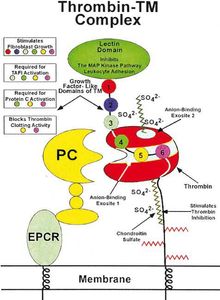Thrombomodulin is the key anticoagulant molecule of the blood vessel wall inhibiting the pro-coagulant activity of thrombin and activating the anticoagulant protein C pathway. The project aims at the creation of actively hemocompatible surfaces with the potential for clinical application by dissecting and simulating the synergistic mechanisms of both anticoagulant functions of thrombomodulin using immobilized thrombin inhibitors, Activated Protein C (APC, Xigris®) and a direct activator of protein C (Protac®). For simulating the thrombomodulin action, these molecules will be immobilized in a micropattern locally separated but close enough for rapid diffusion processes.
Alternatively, complexes of APC and a low binding competitive inhibitor for both thrombin and APC will be immobilized. A suitable inhibitor will be identified in the study. Upon dissociation of the complex, APC activity and thrombin inhibitory effects will be available, closely simulating the physiological action of thrombomodulin.The concept will be tested in model solutions, in plasma and in blood. The combined application of the two inhibitory principles has a great potential to improve current strategies of anticoagulant surface modification and furthermore provides insight in the synergistic action of Protein C activation and thrombin inhibition. The immobilization of APC in complex with a low binding inhibitor is conceptually new in the field of surface functionalization. Advantages concerning enzyme activity and a dual function of the applied inhibitor molecule is expected.


